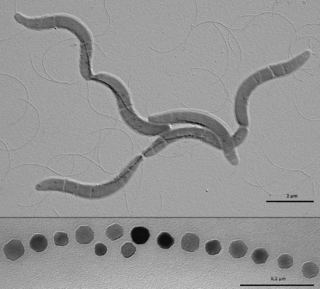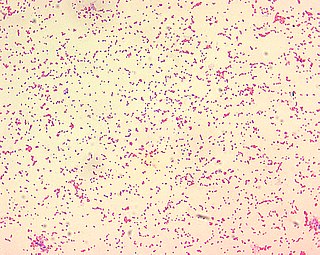
Pseudomonadota is a major phylum of Gram-negative bacteria. The renaming of several prokaryote phyla in 2021, including Pseudomonadota, remains controversial among microbiologists, many of whom continue to use the earlier name Proteobacteria, of long standing in the literature. The phylum Proteobacteria includes a wide variety of pathogenic genera, such as Escherichia, Salmonella, Vibrio, Yersinia, Legionella, and many others. Others are free-living (non-parasitic) and include many of the bacteria responsible for nitrogen fixation.

The Rhodospirillales are an order of Pseudomonadota.

Rhizobium is a genus of Gram-negative soil bacteria that fix nitrogen. Rhizobium species form an endosymbiotic nitrogen-fixing association with roots of (primarily) legumes and other flowering plants.

Agrobacterium is a genus of Gram-negative bacteria established by H. J. Conn that uses horizontal gene transfer to cause tumors in plants. Agrobacterium tumefaciens is the most commonly studied species in this genus. Agrobacterium is well known for its ability to transfer DNA between itself and plants, and for this reason it has become an important tool for genetic engineering.

Micromonosporaceae is a family of bacteria of the class Actinomycetia. They are gram-positive, spore-forming soil organisms that form a true mycelium.

The Hyphomicrobiales are an order of Gram-negative Alphaproteobacteria.

The Rhodobacteraceae are a family of Pseudomonadota in the order Rhodobacterales within the alpha subgroup. Like all Pseudomonadota, they are gram-negative. It contains chemoorganotrophs and photoheterotrophs bacteria. Many occur in aquatic habitats.

The Brucellaceae are a family of the Gram-negative Hyphomicrobiales. They are named after Sir David Bruce, a Scottish microbiologist. They are aerobic chemoorganotrophes. The family comprises pathogen and soil bacteria
The Eubacteriales are an order of bacteria placed within the class Clostridia.

The Actinomycetia are a class of bacteria.

Alphaproteobacteria is a class of bacteria in the phylum Pseudomonadota. The Magnetococcales and Mariprofundales are considered basal or sister to the Alphaproteobacteria. The Alphaproteobacteria are highly diverse and possess few commonalities, but nevertheless share a common ancestor. Like all Proteobacteria, its members are gram-negative and some of its intracellular parasitic members lack peptidoglycan and are consequently gram variable.
The Actinomycetaceae are a family of bacteria in the order Actinomycetales that contains the medically important genus Actinomyces. These organisms are closely related to the mycobacteria, but were originally classified as fungi because they were thought to be transitional forms between bacteria and fungi.
The Nitrobacteraceae are a family of gram-negative, aerobic bacteria. They include plant-associated bacteria such as Bradyrhizobium, a genus of rhizobia associated with some legumes. It also contains animal-associated bacteria such as Afipia felis, formerly thought to cause cat-scratch disease. Others are free-living, such as Rhodopseudomonas, a purple bacterium found in marine water and soils. The strain Rhodopseudomonas palustris DX-1 can generate an electric current with no hydrogen production, a trait being explored in the development of the microbial fuel cell. The genus Afipia has also been found in the atmosphere, where it uses methylsulfonylmethane as a carbon source.
Phyllobacterium is a genus of Gram-negative, oxidase- and catalase-positive, aerobic bacteria.
Neorhizobium is a genus of Gram-negative soil bacteria that fix nitrogen. It was recently segregated from the genus Rhizobium. Neorhizobium forms an endosymbiotic nitrogen-fixing association with roots of legumes.
Pararhizobium is a genus of Gram-negative soil bacteria that fix nitrogen. Some species of Pararhizobium form an endosymbiotic nitrogen-fixing association with roots of legumes.
Allorhizobium is a genus of Gram-negative soil bacteria. Some species of Allorhizobium form an endosymbiotic nitrogen-fixing association with roots of legumes, while others are known to cause crown gall.
Devosiaceae is a family of Alphaproteobacteria.
Peteryoungia is a genus of bacteria from the family Rhizobiaceae.









